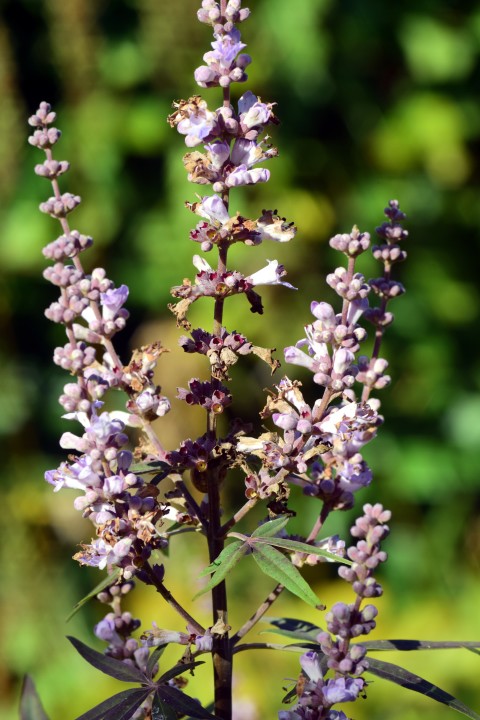Chaseberry

Chaseberry… everyone knows it, right?
How often the menstrual period and sometimes a child, overdue, waiting… that somehow fits this plant: Chaseberry. Vitex agnus castus, Latin for “the chaste lamb”, because it was added to herbal beer in the Middle Ages to curb the sex drive of monks. However, the idea of using this plant to curb the male sex drive did not originate in the monastery kitchens of the Dark Ages, but was already an issue in ancient Rome. The first preserved description of the semi-shrub native to the Mediterranean region comes from Dioscorides. The Greek physician was, among other things, an advisor on medical problems in the army of Emperor Caligula and discussed with the officers the problem of the excess “energy” of young soldiers in the army camp in view of the lack of women. …. Dioscorides knew nothing of testosterone and hormones, but he recommended seasoning the wine for the soldiers with the berries of the Chaseberry. “Boys, wait until we get to the next town, stay calm and don’t beat each other up.” It was also about avoiding brawls in the camp.
Does Chaseberry suppress male hormones?
Is it a plant that suppresses male hormones? No, it is a medicinal plant that promotes the production of female sex hormones, especially progesterone. Women need and have a little male hormones, just as men need to have a little female hormones in their bodies. Not too much, not too little, as always a matter of balance. Clever of our body that it makes all sex hormones (and also cortisol) from cholesterol and can convert them into each other with the help of enzymes. From testosterone, for example, it can produce estriol, our mucosal protective hormone that protects against frequent bladder and vaginal infections.
Chaseberry lowers prolactin, lactation and stress hormone.
Suppressing testosterone, as almost all birth control pills do, is not the purpose of chaste peppers. Rather, Chaseberry is active in another area, it promotes the formation of progesterone, the corpus luteum hormone, our hormone of wisdom and introspection that we form well whenever we are relaxed. Agnus castus has been shown to lower elevated levels of prolactin, the milk-forming hormone that, among other things, keeps us from getting pregnant again so quickly when we are breastfeeding. But it is also one of the stress hormones. During periods of stress, the body of many a woman finds the idea of having to feed a baby an imposition. Some become pregnant very quickly in stressful situations, others react very quickly with cycle postponements as soon as the internal and external pressure increases.
When does treatment with Chaseberry make sense?
And this brings us to the first symptoms for which treatment with Chaseberry is a possibility: Chaseberry can be used in cases of an unfulfilled desire to have children, prolonged and rather irregular menstrual cycles and an unstable luteal phase. The not so tingling function of the corpus luteum and the relative lack of progesterone often manifest themselves in breast tenderness before menstruation, water retention and the excess water also likes to drip from the eyes. …. Emotionally, when chasteberry fits as a medicinal plant, the period before menstruation corresponds to a rather depressed and tearful mood, often with food cravings.
Chaseberry during puberty but also during menopause
It is a helpful plant in phases of hormonal change: gladly in puberty, when the cycles are irregular, long and painful, the bleedings sometimes heavy and before the period the Weltschmerz sets in. But also when the menopausal cycle suddenly behaves like puberty again… “I last had such abdominal cramps during bleeding when I was 16”. Well, menopause is in some ways reverse puberty, so why not rediscover a plant that helps grow into a regular cycle. This can also help with getting off and “getting off cycle”.
Do all the signs have to be present to take Chaseberry?
With medicinal plants, individual symptoms are quite sufficient. So it doesn’t have to be the whole cocktail of breast tenderness, weepy depressive PMS, prolonged or irregular menstrual cycle, and menstrual cramps during bleeding in front behind the Venus bone (symphysis) to prescribe Chaste Pepper… But the plant has to fit the woman. Sometimes I have the feeling that if some colleagues know a medicinal plant, then it is Agnus castus, and it must then be used for everything that it cannot and does not have to do. Yet there are so many beautiful medicinal plants! Chaseberry can give the ovaries a bit of steam under the butt and stimulate them to produce more progesterone and dampen prolactin production in the pituitary gland, there are scientific studies on this. Especially for women who are very “purely stressed” with their desire to have children and are shooting themselves in the foot a bit, this can be wonderful. The reduction of the breastfeeding and stress hormone prolactin then often also promotes libido and allowing relaxation. I wonder if that’s where the Mediterranean influence comes through. The plant that thrives so well in countries where the sun shines more, the clocks often go a little slower and the idea of the siesta was born?
Chaseberry, not always the right plant
There are also women who do not tolerate Chaseberry so well, they are irritated by Chaseberry. Unlike men, women’s libido is rarely in the basement under the influence of Agnus Castus, but if it is, it is a clear sign that this plant is not suitable for this woman. In polycystic ovary syndrome (PCO), where the menstrual cycle is also prolonged but an increase in male sex hormones is prominent and prolactin is almost always in the normal range, other plants take the lead. Even in post-pill amenorrhea, the absence of menstruation after taking the pill, Chaseberry is not the panacea or the patent solution to all problems. And “the universal remedy for PMS is Chaseberry certainly not!”
I’ll tell you more about PMS and the plants, but also hormones, soon, also in the specialized course (German only). But before that, here is a summary of the most important symptoms that speak for Chaseberry:
• Agnus castus shortens the menstrual cycle in case of regularly prolonged menstruation
• lowers excessively high prolactin
• PMS with breast tenderness and tearful depressed moods
• Menstrual cramps during bleeding in the front of the abdomen behind the symphysis

Written by Dr Dorothee Struck
More From This Category
Hypnosis for endometriosis
Hypnosis for endometriosisOne of the common diseases that affect one in ten women in the course of their lives, and which in many cases is accompanied by pronounced pain, is endometriosis. Hypnosis is recognized by medical associations in Germany, although only for...
Hypnosis for endometriosis
Hypnosis for endometriosisOne of the common diseases that affect one in ten women in the course of their lives, and which in many cases is accompanied by pronounced pain, is endometriosis. Hypnosis is recognized by medical associations in Germany, although only for...
Hypnosis for endometriosis
Hypnosis for endometriosisOne of the common diseases that affect one in ten women in the course of their lives, and which in many cases is accompanied by pronounced pain, is endometriosis. Hypnosis is recognized by medical associations in Germany, although only for...
